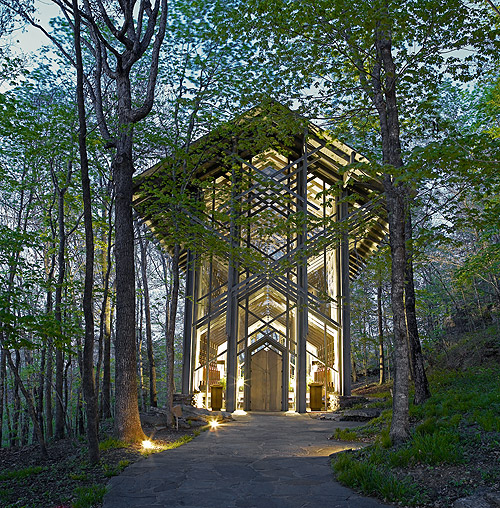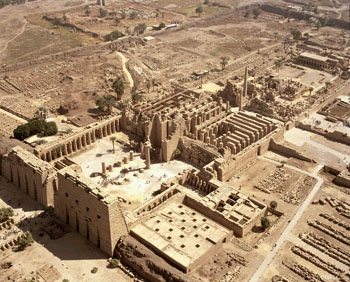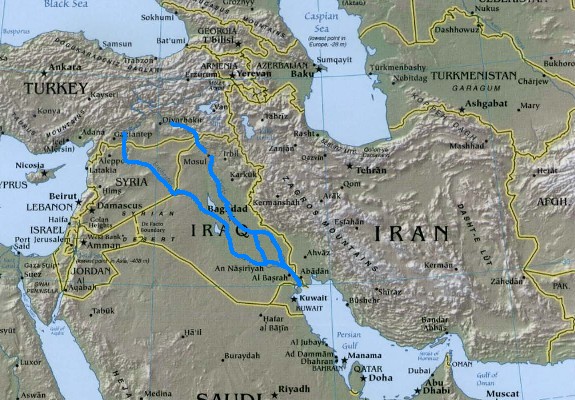|
Carnac, France. Stone lines. C.4500 BCE
|
|
stone work of ca. 4500 BCE The site of long parallel avenues of standing stones, called menhirs, which cross the landscape for a half- mile. The significance of the stone lines is unknown. At Carnac too are dolmens: stone uprights with a spanning stone creating a roof. These may have been used as graves. |
|
Stonehenge (near Salisbury), England. 2950-1500 BCE
|
|
Originally Stonehenge was simply a large circular ditch cut into the earth with a ring of postholes just inside. The postholes held some sort of wood structure, but we don’t know what. In subsequent building programs for the next 1000 years, bluestone pillars were brought from Welsh mountains, and finally the huge sarsen (sandstone) pillars were brought to form a ring of trilthons (pillars with continuous lintels) -- this is the outside ring of stones we see today.
Stonehenge was apparently built for some sacred purpose, but what is unknown. Some claim it was an astronomical observatory, but most consider this to be unfounded. The fact is, we don’t know, and we may never know.
|
| New Mexico Pueblo |
|
In the southwestern US, the density of masonry walls mediates the extreme heat of the day and the cold of the night. The mass of the masonry keeps the temperature of the dwelling more constant. The roof is flat since rain is very infrequent.
|
| New Mexico: masonry, adobe, brick, block |
|
Masonry buildings usually have prominent and protective walls – they are thick. Stone and masonry have no bending strength, so are used for walls, and only used for roofs if the span is very short, or if the roof is a dome. They are strong in compression – they are heavy and hold fast to the earth.
|
|
Northwest Coast Indian Fishing Camps –stick construction – wood, long house
|
|
Northwest Coast Indians traditionally built their shelters and longhouses out of several kinds of available wood: sometimes the cedar planks were removed from the frame and taken to a new camp – from the fishing camp to the forest camp and back again.
|
| Samoa |
|
The climate is mild, so there is no need for a wall to enclose the dwelling, but it is rainy, so a roof that sheds rain is important.
|
| Samoa Wood and Thatch |
|
Wood has little compressive strength, but is very strong in bending (tension). The method of building is like weaving – many slender members tied together. Many Native Americans were nomadic or semi-nomadic, so lightweight buildings that were easy to assemble and disassemble served their purposes. The tipi of the plains Indians was carried from place to place by means of a travois, a horse-drawn sled. In other parts of the world, nomads build light shelters they can take with them, such as the Bedouin who travel the Arabian desert. |
| St. Francis de Asis, Taos, NM |
|
begun 1772 by Spanish Franciscans
|
| Throncrown Chapel, Eureka Springs, AR |
1980 Fay Jones, Architect
|
| Egypt Saqqara: Step pyramid and mortuary temple of zoser 2600 BCE |
|
The step pyramid can be understood as a series of mastabas one on top of the other, with shafts leading below ground level to foil tomb robbers. This is the antecedent of the pyramid. Zoser ruled over the united Upper (south) and Lower kingdoms of Egypt. His funerary complex includes temples and an exterior enclosing wall along with the step pyramid. The columns along the wall have capitals that recall the papyrus plant. |
| Egypt: Giza: Pyramids 2500 BCE |
|
Built over many decades, these funerary monuments have almost no interior space. Like the mastaba they have shafts leading below the ground plane, as well as into the mass of the pyramid itself. The pyramids were built as the final tomb space of a complex that included a river temple and a causeway leading to the pyramid. Smaller pyramids and mastabas, with tombs of nobles and family members, surrounded the Great Pyramids.
|
| Egypt: Karnak: Tample of Ammon 1530-1100 BCE |
|
The Temple of Ammon is dedicated to the sun god Amon-Ra. It was built and changed over many centuries. The building complex exhibits the light-dark contrast that makes Egyptian architecture so dramatic. Open spaces are in brilliant sunlight, but the many-columned hypostyle hall was roofed—its dark interior, combined with the massive scale and closeness of the columns, overwhelms the worshipper. The columns are huge, very tall and thick, with painted and carved relief hieroglyphs decorating their surfaces. The straight axis governs the architecture in the same way that the axis of the Nile orders the culture of ancient Egypt.
|
|
Egypt: Deir-el-Bahri: Temple Tomb of Queen Hatshepsut 1400 BCE |
|
Like Karnak, Queen Hatshepsut’s tomb is strictly axial, and incorporates both dark, enclosed and light, open spaces. A series of ramps ascend toward the ultimate sanctuary, which is dug out of the rock of the cliff wall. Hatshepsut went to great expense to import trees carefully planted along the axis, which reinforced the path. Because the trees were an exotic element to the bare cliff terraces, the trees added to the impression of richness, along with decorative elements including huge sculpture, and carved and painted columns.
|
| Egypt: Abu Simbel: Temple of Ramses 1250 BCE |
|
Ramses II, called the Great because of his successes at war and the general prosperity of Egypt at the time, built many temples and added his image to many earlier buildings. He built two temples in Nubia in southern Egypt to himself and his favorite wife Nefertari. The Temple of Ramses is carved entirely out of the cliff wall, with the axial way to the sanctuary a path tunneled into the cliff. On two days of the year the sun’s rays penetrated to light the farthest sanctuary. The Aswan High Dam, opened in 1970, flooded the original site and it now sits at the bottom of Lake Nasser reservoir. The entire temple, along with the Temple of Nefertari, was cut and moved to a new above-water site. No longer on actual Nile cliffs, their settings are small artificial hills. |
| Ancient Mediterranean: Mesopotamia: |
|
The topography of this region consists of flat fertile soil near the rivers, backed by dry broad hills with very little rock. Cities, including monuments, were built with sun-dried bricks and later, fired tile. The Sumerians, Chaldeans, Babylonians, Assyrians and Persians all struggled for supremacy for over 2000 years before Alexander the Great of Greece conquered the area. |
| Ancient Mediterranean: Tigris and Euphrates Rivers |
|
In what is now Iraq, the several civilizations of the Fertile Crescent – the valleys of the Tigris and Euphrates rivers – and those of the eastern end of the Mediterranean Sea were much less isolated than Egypt. The rivers, seas and shorter distances allowed trade to develop; strong communication, cross-influences and political competition resulted in many contemporaneous rival civilizations, sometimes warlike, always heroic and mythical. These civilizations therefore overlap and interrelate, and the identities of their cultures and their architecture are not so individual as Egypt. Although there are distinct differences, our cursory overvview of the architecture of these cultures focuses on their similarities.
|
| Ancient Mediterranean: Tigres and Euphrates Rivers: Ur: Walled City and Ziggurat 2400-2000 BCE |
|
a Sumerian city-state, is a walled fortress town built of sun-dried mud brick. At its center are a palace and the ziggurat, a stepped pyramid with monumental stairs on one side, and topped with a small temple dedicated to the Moon god Nanna.
|
| Ancient Mediterranean:Tigris and Euphrates Rivers: Babylon: Ziggurat (tower of babel), Hanging Gardens, Ishtar Gate 1600-1100 BCE, 700-500 BCE |
|
is built directly on the Euphrates River, and the river is diverted to a protective moat that surrounds the city. Like Ur, it is surrounded by brick walls, rebuilt in the 7th c. BCE, of kiln-fired and glazed brick. One of the gates, the Ishtar Gate, has been preserved. Babylon had a famous ziggurat, the Tower of Babel, and the legendary Hanging Gardens, probably terraces with plants and fountains, which were named one of the seven wonders of the ancient world.
|
| Ancient Meditteranean: Crete: Minoan Civilization |
|
Topography: hilly rocky terrain with several named mountains; an island in the Aegean Sea
The Minoans had animal-based rituals and worship as in Egypt, but with more reference to other places, such as the mainland of Greece. Legend tells of King Minos, his monster-son the Minotaur and Theseus, the Greek who killed the Minotaur.
Theirs was a marine culture with fertile and abundant decoration, and a myth system that connects it to the oldest stories of the Greeks. Perhaps because the civilization was on an island, the sense of protection was strong, and the architecture emphasizes leisure and pleasure.
|
| Ancient Meditteranean: Crete: Minoan Cvilization: Palace at Knossos 1900-1400 BCE |
|
The palace is built in many levels to respond to its hilly site and to multiple uses – the palace complex held ritual and administrative functions as well as serving as a residence for the royal family and its support staff. Its organization is based on a central open flat courtyard: an outdoor room for play, ritual, entertainment. Around this are grouped small and large rooms, corridors, and stairways, along with servant and storage quarters and workshops. The palace had a central water drainage system. It was built of stone with smooth plaster walls, many with frescoes. Wood was used for roofs, floors and columns. The palace exemplifies the complex social network of the king and queen, nobles and subjects, who lived and worked in the palace as a small city.
|
| Ancient Meditteranean: Greece: Mycenaean Civilization |
|
The topography of the mainland of Greece is rocky and hilly. Limited water makes it difficult to cultivate. The Mycenaeans were a warlike society whose history is the basis for many of the myths and heroes of later Greek culture. Mycenaean culture was far less luxurious and open than the Minoan civilization, although there are many stylistic similarities, and clearly the Mycenaeans knew the Minoan civilization.
The Mycenaean Bronze Age settlements organized themselves in a confederation of city-states, which intermittently made war upon each other, and sometimes allied with one another to make war on others. The cities were built on hills surrounded by walls, highly defensible and visible: acropolis (acro=high, polis=city) |
| Ancient Meditteranean: Greece: Mycenae: Acropolis, lions gate, cyclopean walls, megaron c. 1500 BCE |
|
acropolis (acro=high, polis=city)
The city of Mycenae itself was an acropolis, surrounded by walls built of huge stones, called cyclopean because they were thought to be built by giants, or Cyclops. Its main gate is called the Lion Gate because of the sculptural decoration above the gateway. The megaron, the king's ceremonial hall was in the center of the fortified city, its most protected place.
|
| Ancien Meditteranean: Greece: Tiryns: Megaron c. 1500 BCE |
|
Tiryns was a coast city and so the environment was not so forbidding as that of Mycenae. It too is a walled city with an acropolis and a megaron.
The deeds of the Mycenaeans are the source of many Greek myths, which concern gods and heroes, and they were the Greeks who fought at Troy, ultimately destroying the city. A blind storyteller, Homer, is credited with passing the story down into recorded history into what we now call The Iliad. For many centuries this story was thought to be fictitious, until 19th century archaeologists found the remains of both Mycenae and Troy.
The Mycenaean megaron, the audience hall of the king and the most protected place within the acropolis, is considered the formal source for the Greek temple.
|
















